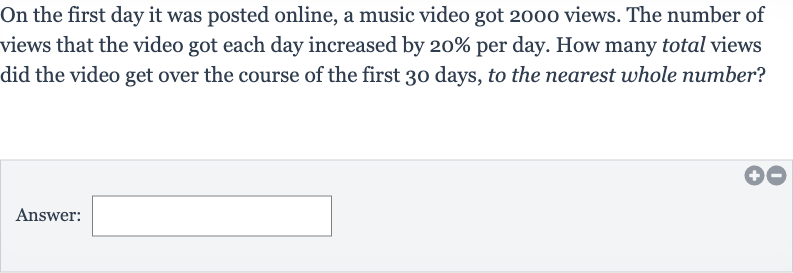AI tutor
Welcome to Bytelearn!
Let’s check out your problem:

On the first day it was posted online, a music video got views. The number of views that the video got each day increased by per day. How many total views did the video get over the course of the first days, to the nearest whole number?Answer:
Full solution
Q. On the first day it was posted online, a music video got views. The number of views that the video got each day increased by per day. How many total views did the video get over the course of the first days, to the nearest whole number?Answer:
- Identify initial number of views: Identify the initial number of views and the daily increase rate.The initial number of views is , and the daily increase rate is or in decimal form.
- Determine formula for total views: Determine the formula for the total number of views after a certain number of days.The total number of views after days can be calculated using the formula for the sum of a geometric series: , where is the common ratio .
- Calculate common ratio: Calculate the common ratio for the geometric series.The common ratio is the daily increase rate, which is .
- Calculate total views after days: Calculate the total number of views after days using the formula.Substitute the values into the formula: .
- Evaluate expression within brackets: Evaluate the expression within the brackets first.Calculate and then subtract it from .
- Calculate denominator of fraction: Calculate the denominator of the fraction.The denominator is , which is .
- Divide result by denominator: Divide the result from Step by the result from Step . This will give us the total multiplier to be applied to the initial number of views.
- Multiply initial views by total multiplier: Multiply the initial number of views by the total multiplier to find the total number of views. This will give us the total number of views the video got over the course of the first days.
- Round result to nearest whole number: Round the result to the nearest whole number as the final answer.
- Perform calculations: Perform the calculations.First, calculate : Then, subtract this from : Now, divide by : Finally, multiply by the initial number of views: Round to the nearest whole number:
More problems from Exponential growth and decay: word problems
QuestionGet tutor help
QuestionGet tutor help
QuestionGet tutor help
QuestionGet tutor help
QuestionGet tutor help
QuestionGet tutor help
QuestionGet tutor help
QuestionGet tutor help
QuestionGet tutor help
